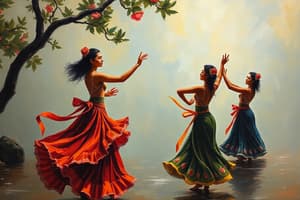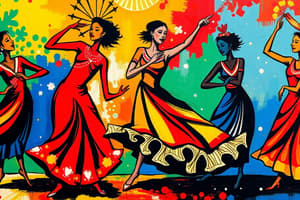Podcast
Questions and Answers
Which dance belongs to the Maria Clara suite of Philippine folk dances?
Which dance belongs to the Maria Clara suite of Philippine folk dances?
- Maglalatik
- Cariñosa (correct)
- Tinikling
- Pandanggo sa Ilaw
What is the historical origin of the cariñosa dance in the Philippines?
What is the historical origin of the cariñosa dance in the Philippines?
- American
- Asian
- Native
- Hispanic (correct)
Who was the main character in Jose Rizal's novel Noli Me Tangere, from which the Maria Clara suite of Philippine folk dances derives its name?
Who was the main character in Jose Rizal's novel Noli Me Tangere, from which the Maria Clara suite of Philippine folk dances derives its name?
- Elias
- Ibarra
- Don Rafael
- Maria Clara (correct)
Which dance was named the national dance of the Philippines during the Marcos regime?
Which dance was named the national dance of the Philippines during the Marcos regime?
What is the significance of the shy behavior of the female dancer in Cariñosa?
What is the significance of the shy behavior of the female dancer in Cariñosa?
Flashcards
Maria Clara Suite Dance
Maria Clara Suite Dance
Cariñosa is a courtship dance that belongs to the Maria Clara suite.
Origin of Cariñosa
Origin of Cariñosa
The Cariñosa dance has Hispanic origins, showing Spanish influence in Philippine culture.
Inspiration for Maria Clara Suite
Inspiration for Maria Clara Suite
Maria Clara, the main character in Jose Rizal's 'Noli Me Tangere', inspired the suite of Philippine folk dances.
National Dance of Philippines
National Dance of Philippines
Signup and view all the flashcards
Significance of Shyness
Significance of Shyness
Signup and view all the flashcards
Study Notes
Philippine Folk Dances
- The Maria Clara suite of Philippine folk dances is associated with the Cariñosa dance.
Historical Origin of Cariñosa
- The Cariñosa dance originated in the Philippines during the Spanish colonial era, specifically in the 17th century.
- It was inspired by the Filipino adaptation of the Spanish contradanza, a courtship dance.
Maria Clara and Noli Me Tangere
- The Maria Clara suite of Philippine folk dances derives its name from the main character, Maria Clara, in Jose Rizal's novel Noli Me Tangere.
National Dance of the Philippines
- The Tinikling dance was named the national dance of the Philippines during the Marcos regime.
Significance of Shy Behavior in Cariñosa
- The shy behavior of the female dancer in Cariñosa symbolizes the modesty and elegance of the Filipina woman.
Studying That Suits You
Use AI to generate personalized quizzes and flashcards to suit your learning preferences.




